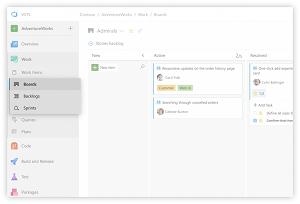News
While GitHub Waits in the Wings, Work on Visual Studio Team Services Continues
The big news around collaborative coding in the Microsoft ecosystem has lately focused on the impending GitHub acquisition, but work is continuing on improving the existing Visual Studio Team Services platform.
In the last couple of days, the VSTS team has announced several new improvements in response to developer feedback and previewed even more to come in the future.
After the GitHub acquisition was announced, the VSTS team promised that both offerings will live on as parallel alternatives -- albeit with deeper integration -- while work continues to improve VSTS and Team Foundation Server (TFS) with the goals of making them more modular, providing a more modern UI and more.
Part of that includes new navigation, announced in a blog post earlier this week. "Our goal to create an integrated suite that also gives the flexibly to pick and choose the services that work best for you," the post said. "That goal is a common customer request and at the heart of this new design."
Navigation improvements include: a new design style based on the Fluent design language, moving project navigation to the left in order to clearly separate project and global spaces; a "create new" button next to the project name in project navigation; and several more.
And just today (June 22), the VSTS team announced new work hubs, generated from talks with users who struggled with the complexity of the existing Backlogs hub, which was found to host too many features. To simplify things, it's being divided into three hubs: Backlogs, Boards and Sprints.
 [Click on image for larger view.] New Boards, Backlogs and Sprints Navigation Hubs (source: Microsoft).
[Click on image for larger view.] New Boards, Backlogs and Sprints Navigation Hubs (source: Microsoft).
Also, as part of that broader navigation update mentioned above, team context will no longer be a part of the global breadcrumb, rather moving to a more person-centric navigation scheme. "Now, you're able to favorite individual backlogs, boards, and sprints across any team, making navigation between these items significantly easier," the VSTS team said in a post. "Additionally, quick search is available in every item picker to help you find things you haven't favorited."
Other improvements include a new Team Profile pane to provide quick access to related team items along with ancillary information about administrators and members. Also new are Sprint features for easily creating a new Sprint or subscribing to an existing one, and more dealing with planning, new work items and updated filters -- with the promise of more to come.
"These changes are just the first steps in a set of larger changes," the post said. "If you're worried that teams are going away, rest assured that teams are still an important artifact in VSTS. We've spent the better part of the last year learning from many of you about the wide variety of approaches and uses for teams. It's been extremely helpful and is informing how we think about the future."
Future goals include providing more flexibility for backlogs, boards and sprints to make them useful with or without teams. "In fact, that's where we're headed next," the post said. "We plan to unlock boards from teams so you can create custom boards for a variety of scenarios."
The new functionality is unlocked by clicking on Enable preview features from the developer profile in the upper right-hand corner of a VSTS project.
About the Author
David Ramel is an editor and writer at Converge 360.